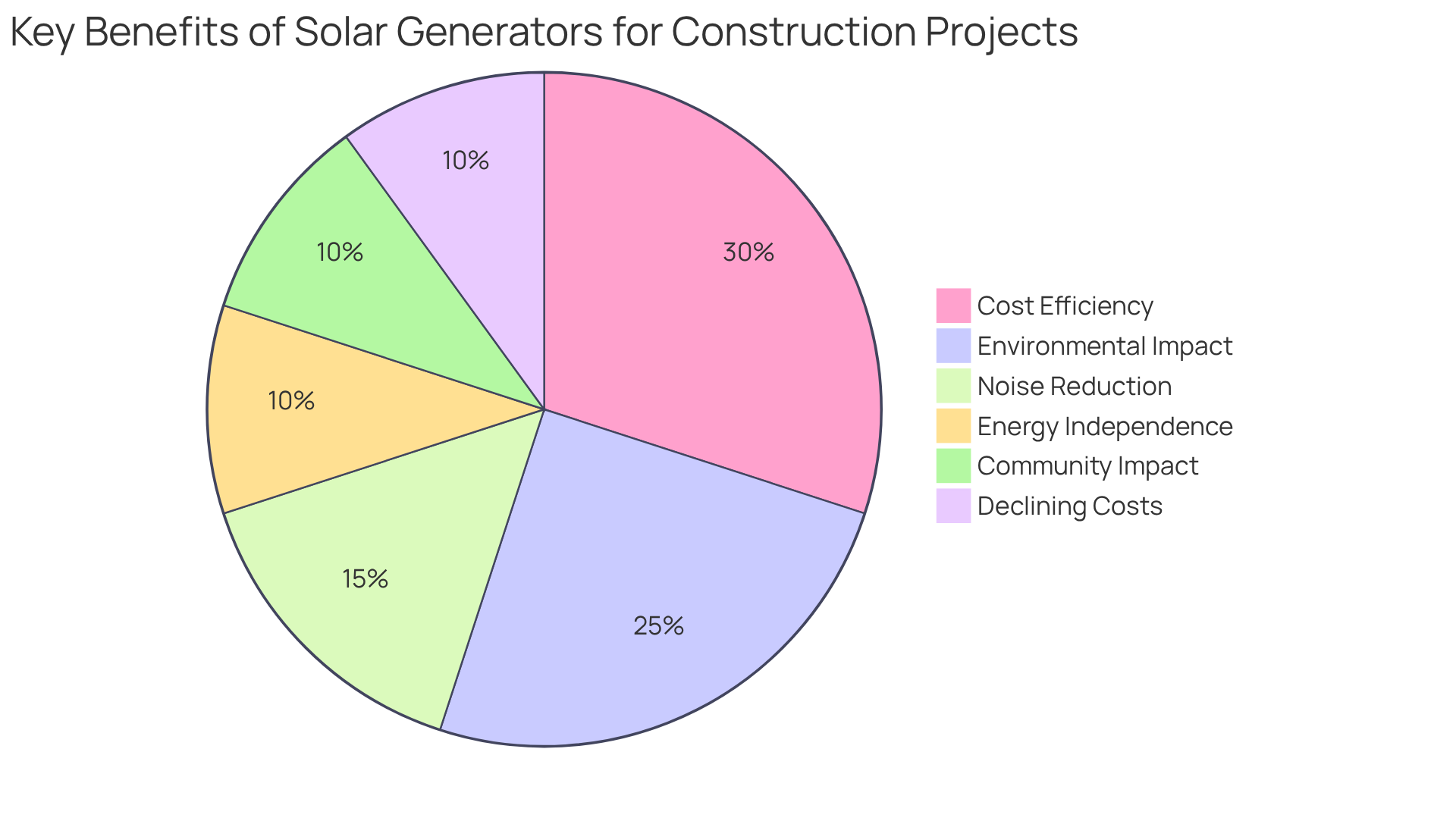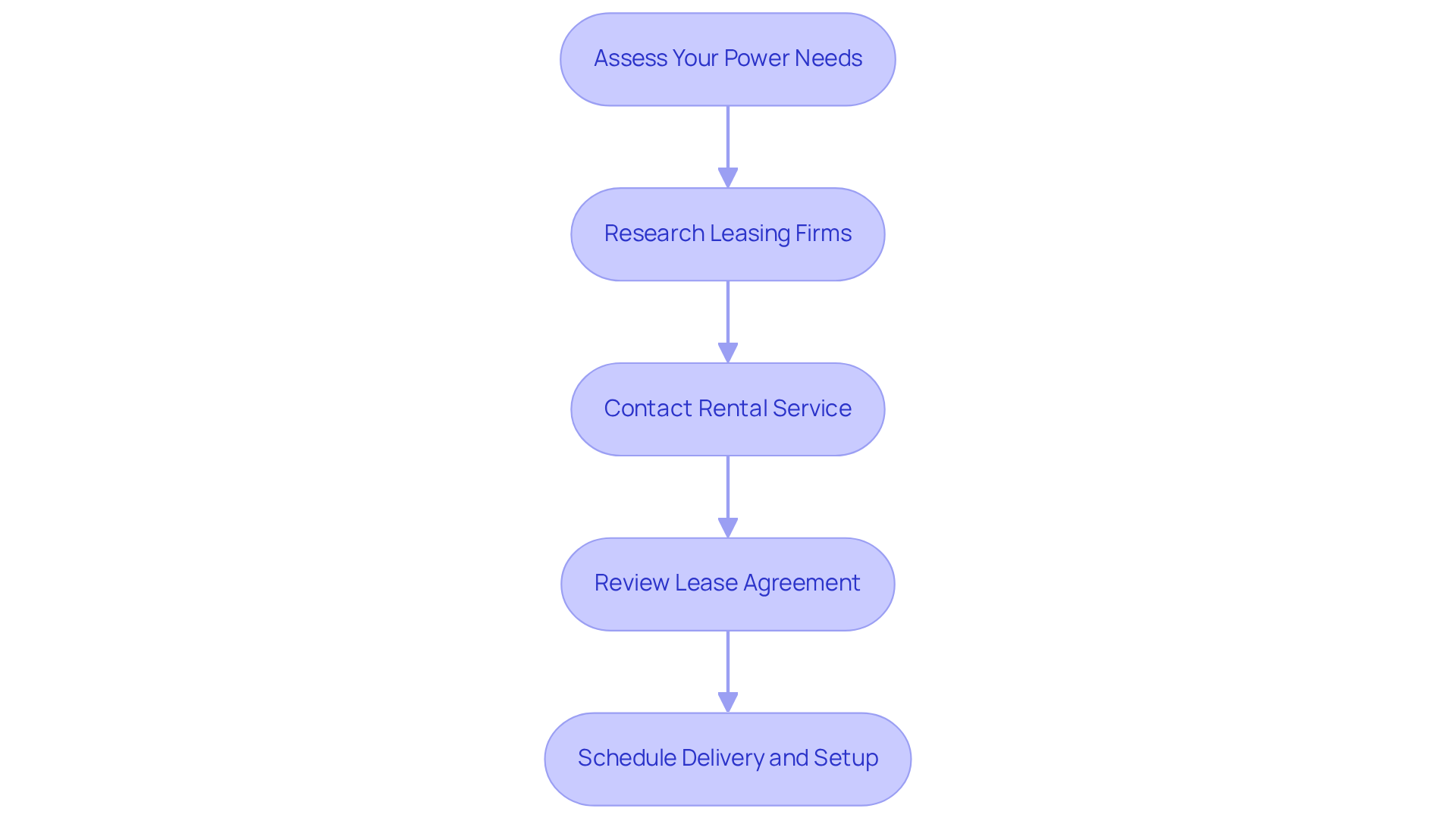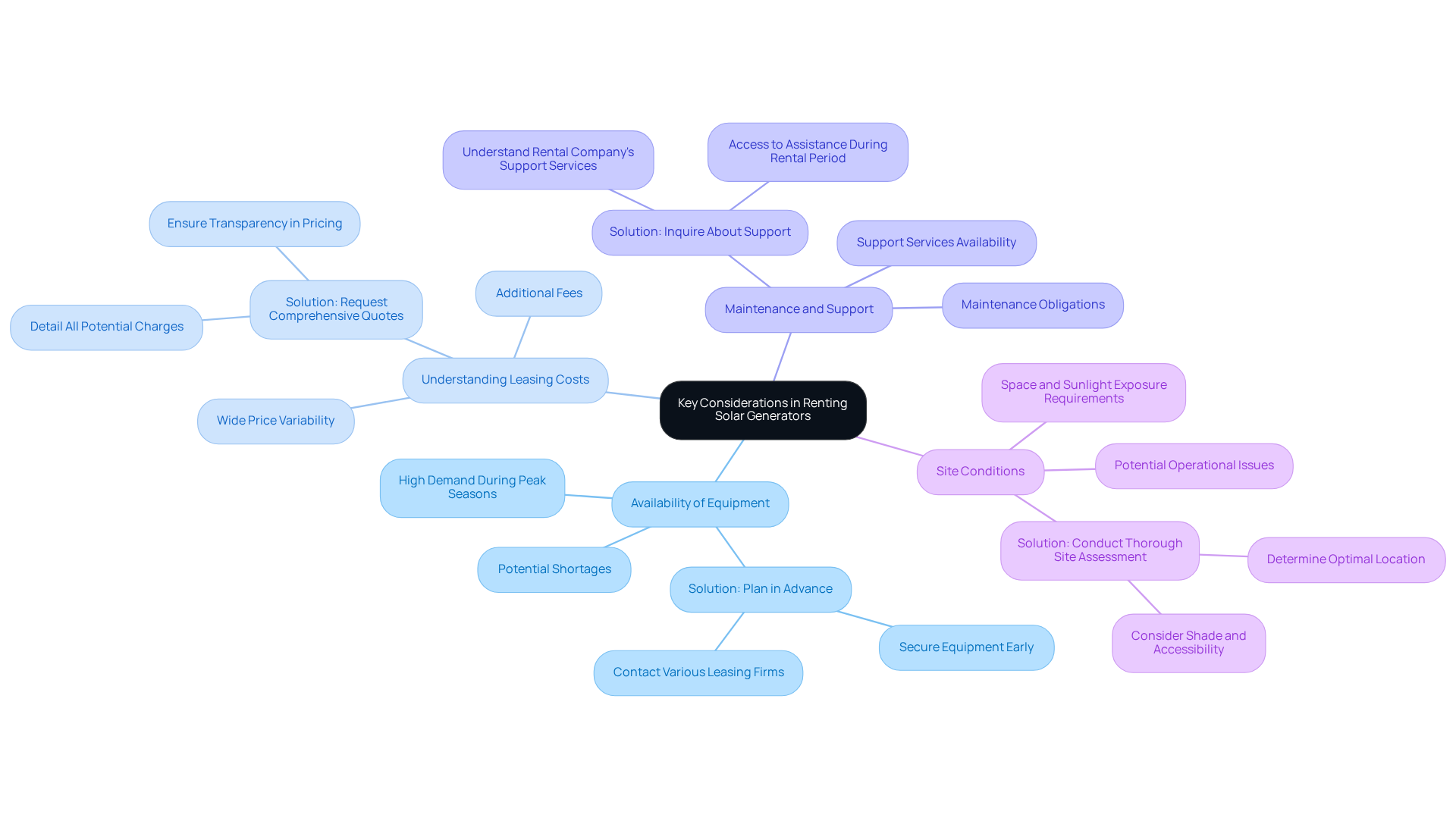Overview
To successfully rent a solar generator for your construction project, it is essential to assess your power needs accurately. Begin by researching reputable leasing firms that specialize in solar equipment. Understanding the intricacies of lease agreements is crucial; a careful review can prevent potential pitfalls down the line. Furthermore, being aware of challenges such as equipment availability and maintenance obligations will ensure a smooth rental experience.
Emphasizing the importance of these steps not only maximizes the benefits of utilizing solar generators but also enhances cost efficiency and positively impacts the environment. By taking these factors into account, you position yourself to make informed decisions that align with your project's goals. In addition, recognizing the reliability and quality of the equipment can significantly influence your overall satisfaction.
In conclusion, engaging with reputable firms and understanding the leasing process is vital for optimizing your solar generator rental experience. Take action now to ensure that your construction project benefits from the advantages of solar power, including reduced costs and a smaller carbon footprint.
Key Highlights:
- Solar generators convert sunlight into electricity, providing a portable and reliable power source.
- They produce no emissions, making them a cleaner alternative to gas generators, contributing to reduced carbon footprints.
- Initial rental costs may be higher, but solar generators can save up to 30% on fuel costs over time.
- Solar generators operate quietly, minimising noise pollution in residential areas.
- They offer energy independence in remote locations where traditional power is unavailable.
- Transitioning to renewable energy can create jobs and uplift marginalised communities.
- The cost of photovoltaic systems has decreased by 37% since 2013, improving economic viability.
- To rent a solar generator, assess power needs, research leasing firms, and review lease agreements carefully.
- Challenges include equipment availability, understanding leasing costs, maintenance obligations, and site conditions.
- Planning ahead and conducting thorough site assessments can enhance the effectiveness of solar generator rentals.
Introduction
The construction industry is increasingly embracing innovative solutions to meet its energy needs, with solar generators leading this transformative movement. These portable power stations not only provide a cleaner and quieter alternative to traditional generators but also deliver significant cost savings and energy independence. As the demand for these eco-friendly devices surges, construction professionals must navigate the complexities of the rental process.
How can they ensure they select the right solar generator while steering clear of common pitfalls?
Understand Solar Generators and Their Benefits
Sunlight-powered units are portable energy stations that transform sunlight into electricity using photovoltaic panels. These systems store energy in batteries, ensuring a reliable power supply even when the sun isn't shining. Understanding the benefits of solar generators on construction sites is crucial for making informed decisions:
-
Environmental Impact: Solar generators produce no emissions, making them a cleaner alternative to traditional gas generators. As David Suzuki states, "Renewable energy - wind, geothermal, hydroelectric, and tidal - is the future," underscoring the importance of clean energy sources in reducing carbon footprints.
-
Cost Efficiency: While the initial expense to rent a solar generator may be higher, photovoltaic systems can lead to significant savings over time by reducing fuel costs and maintenance. Research shows that utilizing photovoltaic power sources can cut fuel costs by up to 30% compared to conventional devices, making them a financially prudent choice for construction projects.
-
Noise Reduction: In contrast to gas-powered units, solar-powered systems operate quietly, which is particularly beneficial for projects in residential areas or sound-sensitive environments. This capability allows for uninterrupted work without disturbing nearby residents.
-
Energy Independence: Solar generators offer a dependable power source, especially in remote locations where traditional power may be unavailable. This reliability ensures that construction activities can continue without interruptions due to power outages.
-
Community Impact: Transitioning to renewable energy not only enhances individual projects but also has the potential to uplift historically marginalized communities by creating jobs and promoting sustainable practices.
-
Declining Costs: The costs associated with photovoltaic technology have been decreasing, making these systems more accessible. Since 2013, the average cost of photovoltaic systems has dropped by 37%, further supporting their economic viability.
Recognizing these advantages will empower you to make an informed decision when you choose to rent a solar generator for your construction project.

Follow the Steps to Rent a Solar Generator
To rent a solar generator for your construction project, follow these essential steps:
-
Assess Your Power Needs: Begin by calculating the total wattage required for your tools and equipment. This will guide you in selecting a generator with adequate capacity. Tip: Compile a comprehensive list of all devices you intend to power, including their wattage requirements. Be sure to factor in both starting and running wattages to avoid any shortfalls.
-
Research Leasing Firms: Identify reputable equipment leasing companies in your vicinity, such as EZ Equipment Lease, recognized for their commitment to quality and reliability. Tip: Take the time to review online testimonials and seek recommendations from colleagues within the construction industry. This will help you gauge the reliability of potential leasing partners.
-
Contact Rental Service: You can choose to rent a solar generator. Get in touch with the rental service to contact your chosen leasing company and inquire about the availability, leasing conditions, and pricing options to rent solar generator units. Tip: Prepare to discuss your project timeline and specific power needs. This ensures you receive the most suitable generator tailored to your requirements.
-
Review Lease Agreement: Carefully examine the lease agreement, paying close attention to terms related to usage, maintenance responsibilities, and insurance coverage. Tip: If any terms seem ambiguous, clarify them with the leasing company to prevent misunderstandings in the future.
-
Schedule Delivery and Setup: Arrange for the timely delivery of the equipment to your job site. Ensure that the rental company provides setup assistance if necessary. Tip: Confirm the delivery date and time to align with your project schedule, thereby minimizing any potential downtime.

Address Key Considerations and Challenges in Rental
When you rent a solar generator, several challenges must be considered to ensure a smooth experience.
Availability of Equipment: Solar generators can be in high demand, particularly during peak construction seasons, leading to potential shortages. To alleviate this, it is wise to plan in advance and secure your power source early.
- Solution: Contact various leasing firms to compare availability and ensure you obtain your equipment well in advance. According to industry insights, the power supply leasing market is anticipated to reach USD 5.2 billion by 2033, indicating rising demand.
Understanding Leasing Costs: Leasing prices for solar generators can vary widely based on capacity and leasing duration, typically ranging from USD 500 to USD 4000. It's crucial to grasp the total cost, including any additional fees that may apply.
- Solution: Request a comprehensive quote from the leasing company that details all potential charges, ensuring transparency in pricing. For instance, a representative from EZ Equipment Rental noted, "Understanding the cost structure is essential for project managers to avoid unexpected expenses."
Maintenance and Support: While photovoltaic systems generally need less upkeep than their gas equivalents, it's crucial to comprehend your maintenance obligations as detailed in the leasing contract.
- Solution: Inquire about the rental company's support services for equipment issues that may arise during your rental period, ensuring you have access to assistance when needed.
Site Conditions: Sufficient space and sunlight exposure are essential for the effective functioning of solar power systems. Assessing your job site beforehand can prevent operational issues.
- Solution: Conduct a thorough site assessment to determine the optimal location for the power source, taking into account factors such as shade and accessibility. A case analysis from a recent undertaking emphasized how appropriate site assessment resulted in a 20% improvement in power source efficiency.
By addressing these challenges proactively, you can enhance the efficiency and effectiveness of your rent solar generator for your construction project.

Conclusion
Renting a solar generator for construction projects offers a sustainable and efficient solution to power needs. By harnessing solar technology, construction sites can achieve reduced emissions, lower operational costs, and noise-free environments, while fostering energy independence and supporting community development. Recognizing the multifaceted advantages of solar generators empowers project managers to make informed decisions that align with both environmental objectives and budgetary constraints.
The article outlines crucial steps for successfully renting a solar generator, including:
- Assessing power requirements
- Researching leasing firms
- Reviewing lease agreements
It also emphasizes key considerations such as:
- Equipment availability
- Understanding leasing costs
- Ensuring proper site conditions for optimal generator performance
By proactively addressing these factors, construction teams can mitigate challenges and enhance project efficiency.
As the demand for clean energy solutions continues to rise, embracing solar generators not only benefits individual projects but also contributes to a broader movement towards sustainable practices in the construction industry. Taking action to incorporate solar power can lead to significant long-term advantages, making it imperative for construction professionals to explore this renewable energy option for their upcoming projects.
Frequently Asked Questions
What is a solar generator?
A solar generator is a portable energy station that converts sunlight into electricity using photovoltaic panels and stores energy in batteries for reliable power supply even when sunlight is not available.
What are the environmental benefits of using solar generators?
Solar generators produce no emissions, making them a cleaner alternative to traditional gas generators, which helps reduce carbon footprints and supports the transition to renewable energy sources.
How do solar generators contribute to cost efficiency?
Although the initial rental cost for solar generators may be higher, they can lead to significant savings over time by reducing fuel costs and maintenance, with research indicating potential fuel cost reductions of up to 30% compared to conventional devices.
What advantage do solar generators have regarding noise levels?
Solar-powered systems operate quietly, making them particularly beneficial for construction projects in residential or sound-sensitive areas, allowing for uninterrupted work without disturbing nearby residents.
How do solar generators provide energy independence?
Solar generators offer a reliable power source, especially in remote locations where traditional power may not be available, ensuring that construction activities can continue without interruptions from power outages.
What is the community impact of using solar generators?
Transitioning to renewable energy through solar generators can uplift historically marginalized communities by creating jobs and promoting sustainable practices.
Are solar generator costs declining?
Yes, the costs associated with photovoltaic technology have been decreasing, with the average cost of photovoltaic systems dropping by 37% since 2013, making them more accessible and economically viable.




